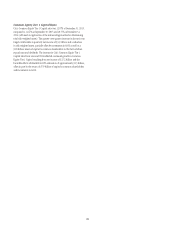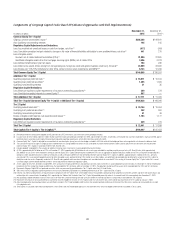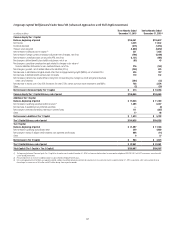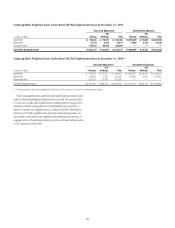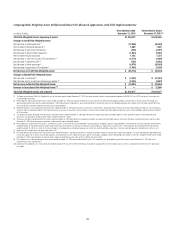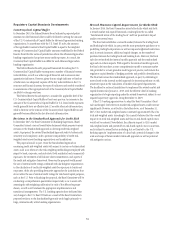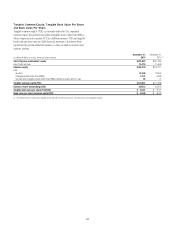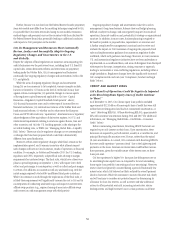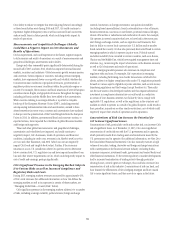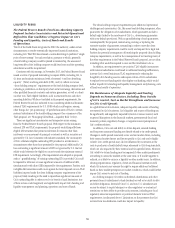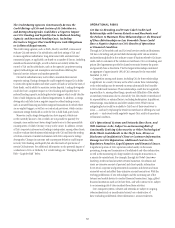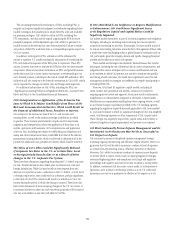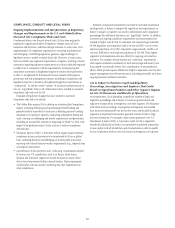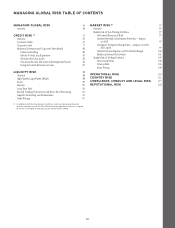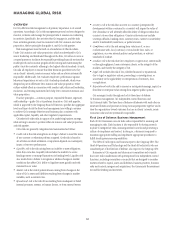Citibank 2015 Annual Report Download - page 72
Download and view the complete annual report
Please find page 72 of the 2015 Citibank annual report below. You can navigate through the pages in the report by either clicking on the pages listed below, or by using the keyword search tool below to find specific information within the annual report.54
Further, because it is not clear how the Federal Reserve Board’s proprietary
stress test models may differ from the modeling techniques employed by Citi,
it is possible that Citi’s stress test results (using its own models, estimation
methodologies and processes) may not be consistent with those disclosed by
the Federal Reserve Board, thus potentially leading to additional confusion
and impacts to Citi’s perception in the market.
Citi, Its Management and Businesses Must Continually
Review, Analyze and Successfully Adapt to Ongoing
Regulatory Changes and Uncertainties in the U.S.
and Globally.
Despite the adoption of final regulations in numerous areas impacting Citi
and its businesses over the past several years, including final U.S. Basel III
capital rules, certain derivatives reforms and restrictions on proprietary
trading under the Volcker Rule, Citi, its management and businesses
continually face ongoing regulatory changes and uncertainties, both in the
U.S. and globally.
While the areas of ongoing regulatory changes and uncertainties
facing Citi are too numerous to list completely, various examples include,
but are not limited to: (i) limits on the level of credit risk Citi may have
against certain counterparties; (ii) potential changes to various aspects
of the regulatory capital framework applicable to Citi (see “Capital
Resources—Regulatory Capital Standards Developments” above);
(iii) financial transaction taxes and/or other types of increased fees on
financial institutions; (iv) international versions of the Volcker Rule and
bank structural reforms; (v) whether and to what extent the European
Union and CFTC will render any “equivalency” determinations or regulatory
acknowledgment of the equivalency of derivatives regimes; (vi) U.S. and
international requirements relating to sanctions against Russia, Iran and
other countries; and (vii) the U.S. banking agencies’ rules relating to the
net stable funding ratio, or NSFR (see “Managing Global Risk—Liquidity
Risk” below). There may also be regulatory changes not yet contemplated,
or changes that have been proposed which could take a dramatically
different form upon finalization.
Moreover, certain recent regulatory changes, while final, remain in the
implementation period, and it remains uncertain what ultimate impact
such changes will have on Citi’s businesses, results of operations or financial
condition. For example, in October and December 2015, the U.S. banking
regulators and CFTC, respectively, adopted final rules relating to margin
requirements for uncleared swaps. The final rules, which have a three-year
phase-in period beginning on September 1, 2016, will require Citi to both
collect and post margin to counterparties, as well as collect and post margin
to certain of its affiliates, in connection with any uncleared swap, with the
initial margin required to be held by unaffiliated third-party custodians.
While Citi continues to work through the implications of the final rules, it
is likely these requirements will significantly increase the cost to Citi and its
counterparties of conducting uncleared swaps and impact its current inter-
affiliate swap practices (e.g., require clearing of more inter-affiliate swaps
and/or enter into risk management swaps with third parties).
Ongoing regulatory changes and uncertainties make Citi’s and its
management’s long-term business, balance sheet and budget planning
difficult or subject to change, and can negatively impact Citi’s results of
operations, financial condition and, potentially, its strategy or organizational
structure. In addition, in many cases, business planning is required to
be based on possible or proposed rules, requirements or outcomes and
is further complicated by management’s continual need to review and
evaluate the impact on Citi’s businesses of ongoing rule proposals, final
rules and implementation guidance from numerous regulatory bodies
worldwide, which such guidance can change. Moreover, in many instances
U.S. and international regulatory initiatives have not been undertaken or
implemented on a coordinated basis, and areas of divergence have developed
with respect to the scope, interpretation, timing, structure or approach,
leading to inconsistent or even conflicting regulations, including within a
single jurisdiction. Regulatory changes have also significantly increased
Citi’s compliance risks and costs (see “Compliance, Conduct and Legal
Risks” below).
CREDIT AND MARKET RISKS
Citi’s Results of Operations Could Be Negatively Impacted
as Its Revolving Home Equity Lines of Credit Continue
to “Reset.”
As of December 31, 2015, Citi’s home equity loan portfolio included
approximately $12.3 billion of home equity lines of credit that were still
within their revolving period and had not commenced amortization, or
“reset” (Revolving HELOCs). Of these Revolving HELOCs, approximately
66% will commence amortization during 2016 and 2017 (for additional
information, see “Managing Global Risk—Credit Risk—Consumer
Credit” below).
Before commencing amortization, Revolving HELOC borrowers are
required to pay only interest on their loans. Upon amortization, these
borrowers are required to pay both interest, usually at a variable rate, and
principal that typically amortizes over 20 years, rather than the typical
30-year amortization. As a result, Citi’s customers with Revolving HELOCs
that reset could experience “payment shock” due to the higher required
payments on the loans. Increases in interest rates could further increase
these payments, given the variable nature of the interest rates on these
loans post-reset.
Citi has experienced a higher 30+ days past due delinquency rate on
its amortizing home equity loans as compared to its total outstanding
home equity loan portfolio (amortizing and non-amortizing). Moreover,
resets to date have generally occurred during a period of historically low
interest rates, which Citi believes has likely reduced the overall payment
shock to borrowers. While Citi continues to monitor this reset risk closely
and will continue to consider any potential impact in determining its
allowance for loan loss reserves, as well as review and take additional
actions to offset potential reset risk, increasing interest rates, stricter
lending criteria and high borrower loan-to-value positions could limit



